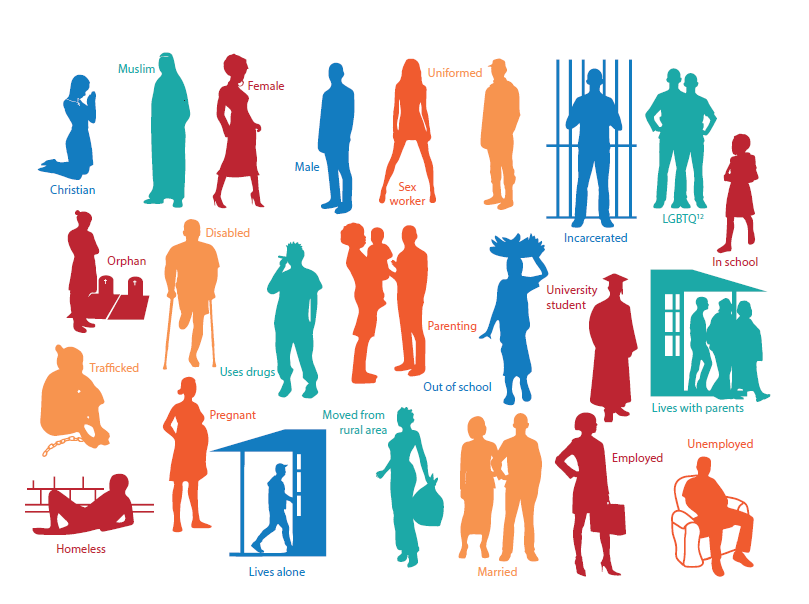- Read the text from beginning to end.
- Complete Worksheet #4 with the data you have from your program or other data sources that can support your program, as well as with information about the young people you would like to reach. If you need help filling it in, refer to the example of Worksheet #4 that has been completed with fictional data from the city of Zanbe.
- Refer to the resources at the end of this Essential Element as needed.
What is the Purpose of this Essential Element?
The purpose of this Essential Element is to:
- Understand why segmenting your audience is helpful.
- Determine which audience segments to choose.
- Use your local data collected to complete Worksheet #4: Segmenting your Audience.
- Determine your primary and secondary audiences.
Why is this Important?
If someone were to ask you whether you are the same as your brother or sister, what would you say? If they were to ask if you were the same as your friend living next door, what would you say? Are you the same as the classmate sitting next to you in school? The young person sitting next to you on the bus? Even the young person who stands next to you in line at the market or shop?
Most likely, you will answer that while some of these people may be similar to you, none are the same as you. Just like you may feel that you are different from your sibling, neighbor or classmate, urban adolescents differ from one another, too! And they differ in many ways. Consider just some of these many different groups that fall within the category “urban adolescents.”
The young people that make up each of these groups have very different lives, needs and responses to messages about SRH.
Different Groups of Urban Adolescents12
Segmentation is important because:
 Different urban adolescent audiences have different SRH needs. Look at the list of different urban adolescent groups outlined in the Who are Adolescents section. Those young people are different from one another. Despite all being in the same city, these young people are living in different places, growing up in different environments, exposed to different things and at risk for different things. A married adolescent has different needs from an unmarried adolescent who is not yet sexually active. A 19 year old will have different needs than a 10 year old. A female sex worker will have different needs than an adolescent boy in school.
Different urban adolescent audiences have different SRH needs. Look at the list of different urban adolescent groups outlined in the Who are Adolescents section. Those young people are different from one another. Despite all being in the same city, these young people are living in different places, growing up in different environments, exposed to different things and at risk for different things. A married adolescent has different needs from an unmarried adolescent who is not yet sexually active. A 19 year old will have different needs than a 10 year old. A female sex worker will have different needs than an adolescent boy in school.
Definition
Audience segmentation is the process of dividing a large population, such as urban youth, into smaller sub-groups so that you can design more effective programs and messages. These sub-groups may be based on any number of the types of groups you see above.
 You can better target your messaging and have more impact. When we just concentrate on one audience (for example, young men that are sexually active and hang out in bars), the programs and messages that we design are far more likely to resonate with our audiences and have an impact than if we tried to reach the entire population of urban adolescents.
You can better target your messaging and have more impact. When we just concentrate on one audience (for example, young men that are sexually active and hang out in bars), the programs and messages that we design are far more likely to resonate with our audiences and have an impact than if we tried to reach the entire population of urban adolescents.
Look at this poster advertisement for condoms in Zambia (on the right). Who would you say is the audience for this poster?
You probably thought something like this:
Young men, 18-24, sexually active, that hang out in bars or pool halls.
 Who among our cast of characters would this poster most speak to?
Who among our cast of characters would this poster most speak to?
Probably Etienne. Could you see Awa or Nadia looking at this poster and being influenced by it? Most likely not.
Now look at this poster for family planning in Haiti (on the left). Who would you say is the audience for this poster?
You might say something like this:
Newly married couples wishing to delay pregnancy until they can graduate from school and earn enough income to support things like a house, travel and children.
Who among our cast of characters would this poster most speak to?
Most likely Nadia or someone older who wants to delay a pregnancy.
Segmenting your audience will help you choose appropriate communication channels. Just like different urban adolescents have different SRH needs, they are also exposed to messaging in different ways. Youth living on the streets may not have as much access to the same communication channels as youth living on a university campus or in stable home environments. Youth who travel around the city all day will likely be exposed to different communication channels than youth who mostly stay home.
Resources
If you want to learn more about the topics covered in this section, visit the Resources section for Essential Element 3.
What are the Key Steps?
When segmenting your audience, here are the key steps to follow:




No Comments